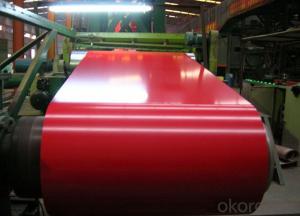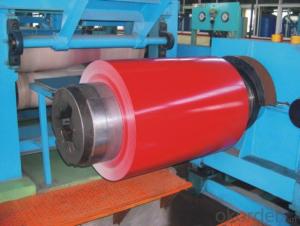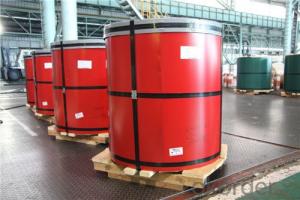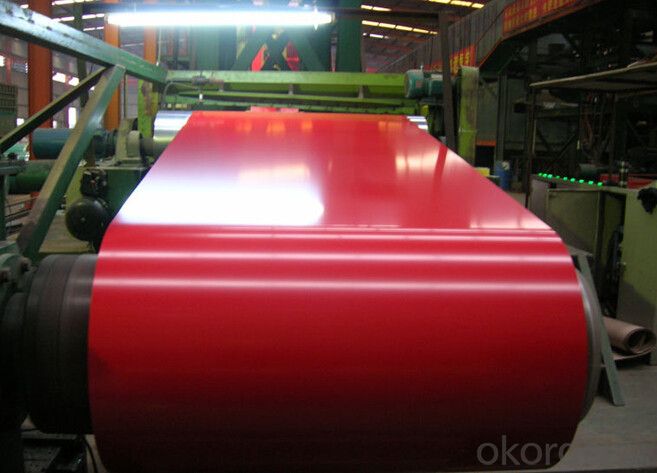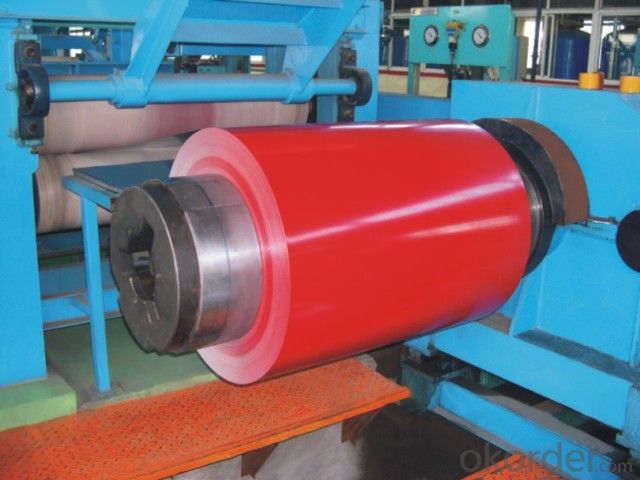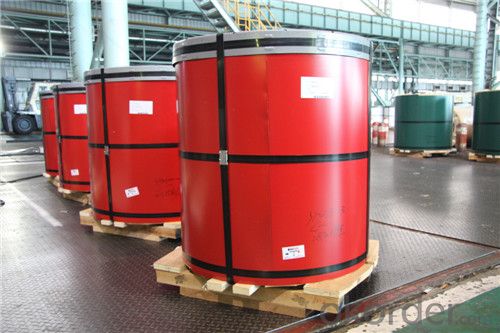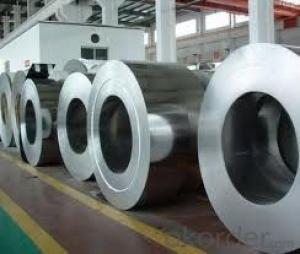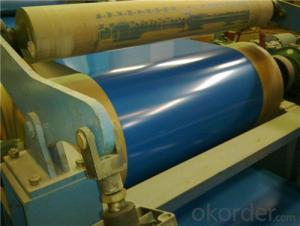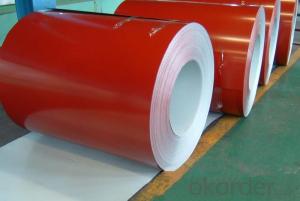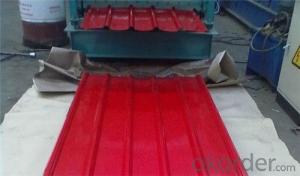color coated galvanized rolled steel coil
- Loading Port:
- Shanghai
- Payment Terms:
- TT OR LC
- Min Order Qty:
- 1 m.t.
- Supply Capability:
- 30000 m.t./month
OKorder Service Pledge
OKorder Financial Service
You Might Also Like
Specifications
1.width: 600-1250mm
2.thickness:0.14-1.20mm
3.zinc coating: 60-180g/m2
PPGI with high quality and various color ,suitable for sandwich panel corrugate steel sheet ppgi, color coated galvanized steel coil, ppgi for metal roof
Applications
1. Construction and building: roofing; ventilating duct; handrail; partition panel;etc.
2. Electric appliance: refrigerator; washing machine; refrigerator; DVD;etc.
3.Transportation: oil tank; road sign; etc.
4.Agriculture:barn; etc.
5.Others:vending machine; game machine; etc.
Name | PPGI |
Description | Prepainted Galvanized Steel Coil |
Type | Steel Coil |
Paint Color | Based on RAL No. or customers' color sample |
Paint | Polyester , and your special requirement to be discussed |
Paint Thickness | 1. Top side: 6+11micron 2. Back side:7 micron 3. Or based on customers' requirement |
Steel Grade | Base material SGCC or your requirement |
Thickness Range | 0.14mm-0.8mm |
width | 750-1250mm |
Zinc Coating | 60-140g/m² |
Coil ID | 508mm |
Coil Weight | 3-6MT, or as per customers’ requests |
Technique | Cold Rolled |
Surface Treatment | Galvanized, Chromated, Unoiled/Oiled, Bright Finished, Spangle, Fingerprint Resistance. |
Application | General Use, Roofing, Corrugated Roofing Making, Outside of the buildings |
- Q: What are the different types of edge treatments for steel coils?
- There are several different types of edge treatments for steel coils, including slit edge, mill edge, and deburred edge. Slit edge is the standard edge treatment, where the coil is slit to the desired width and the edges are left with a rough, jagged finish. Mill edge is a smoother edge treatment that is achieved by cutting the coil using a circular saw, resulting in a cleaner edge. Deburred edge is a further refinement of the mill edge, where the sharp edges are removed through a deburring process, creating a smooth, rounded edge.
- Q: I should have known, but magnets don't stick to stainless steel, so now I'm at a loss, I can't display my photos on the fridge. any ideas?
- An Italian theme would be great for that or just sleek clean lines with the colors stainless steal, red, and accented with black. I like that personally. But it is up to you and what you like and don't like. You could also go an Asian theme. That would be pretty. Asian stuff seems to lean toward reds, greens, and neutrals.
- Q: I'm planning to buy a pair of Doc Marten boots but I want some steel toed ones. I don't know if all of them are steel toed, or only some of them, or what?
- No, okorder /! Ps: if you don't want to buy them new, search off Ebay: there are tons of Dr Martens!!
- Q: Is steel easier to weld?Which is more brittle/less flexible?
- Yes you can, but you really dont want to. Aluminum conducts heat better than steel so the weld would not cool evenly and would be brittle. You would be better off using a bracket or bolt straight on.
- Q: What is the average lifespan of a steel coil?
- The average lifespan of a steel coil can vary depending on several factors. These factors include the quality and type of steel used, the conditions in which the coil is stored or used, and the maintenance and care it receives. Generally, a well-maintained steel coil can last anywhere from 10 to 30 years. However, this is just an estimate and the actual lifespan can be shorter or longer depending on the aforementioned factors. For instance, if the steel coil is exposed to harsh environmental conditions, such as extreme temperatures or corrosive elements, its lifespan may be reduced. Regular maintenance and proper storage can significantly extend the lifespan of a steel coil. This includes ensuring that the coil is stored in a dry and protected environment, regularly inspecting and addressing any signs of corrosion or damage, and conducting routine cleaning and lubrication as needed. Ultimately, the average lifespan of a steel coil is dependent on various factors, and it is best to consult the manufacturer or industry experts for a more accurate estimate based on specific circumstances and conditions.
- Q: What are the main factors that affect the paint adhesion on steel coils?
- The main factors that affect paint adhesion on steel coils include surface cleanliness, surface roughness, surface preparation methods, coating formulation, and application technique.
- Q: During fatigue testing of any material (especially for steels), why is strain-control mode preferred over stress control mode?
- because metals, like steel, are ductile and will stretch before breaking. Straining the metal is stretching it, stressing the metal is applying a shearing force or bending until there is an actual metal failure. A sheet metal strap 1inch across and 24 gauge metal is commonly used to support metal ducting systems in construction. These have an average strain to failure weight load as high as 16,200 lbs. As reported by the smacna index, they will safely hold 6800 pounds. Of more interest is the screws used to hold the strap to the duct. While they are grade 3, fairly strong, they strain to 1400 pounds when properly installed, and are safely able to support 650 pounds, unless they are overtorqued (stripped) and this quickly drops to 400 pounds and 125 pounds...big difference.
- Q: What are the different methods of leveling steel coils?
- There are several methods of leveling steel coils, including roller leveling, stretcher leveling, and tension leveling. Roller leveling uses a series of rollers to gradually bend the steel to achieve a flat surface. Stretcher leveling involves stretching the steel through hydraulic or mechanical means to remove any residual stresses and straighten it. Tension leveling applies tension to the steel coil while passing it through a series of rollers, effectively elongating the material to remove any waviness or curvature.
- Q: I have a set of Stainless steel pots and pans. Everything is sticks to them. What must I do so things don't stick?
- Stainless is great for many things but not so great for some others. Where you want sticking is when you saute meat. You want those crusty brown bits that when the pan is deglazed are the makings of a great sauce. Get yourself one or two non stick pans (preferably with a metal handle so it can go from stove top to oven). Use those where you wish to avoid sticking (like eggs / omelets, french toast or pancakes. Keep in mind that no one pan type is universally good for all types of cooking. My kitchen is mostly stocked with layered stainless steel. I have a few non-stick skillets, a carbon steel wok, a few cast iron skillets, an enameled cast iron dutch oven (le creuset), and a copper sauce pan. Each has its own use.
- Q: I know that steel wool is coated with... something... that protects it from rusting. I need to know what that is, and how to get it off.
- It will be very effective if you remove the oil by appling protective polymer spin coating to the edge, top and underside of the wafer, which makes those surfaces impervious to most chemical etchants. To learn more about the spin coating theory you may check out the following source.
Send your message to us
color coated galvanized rolled steel coil
- Loading Port:
- Shanghai
- Payment Terms:
- TT OR LC
- Min Order Qty:
- 1 m.t.
- Supply Capability:
- 30000 m.t./month
OKorder Service Pledge
OKorder Financial Service
Similar products
Hot products
Hot Searches
Related keywords
